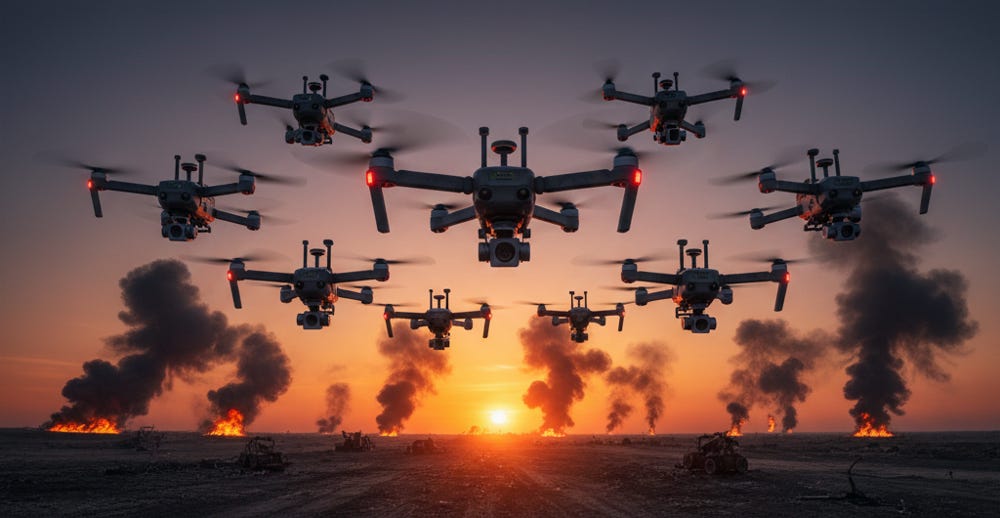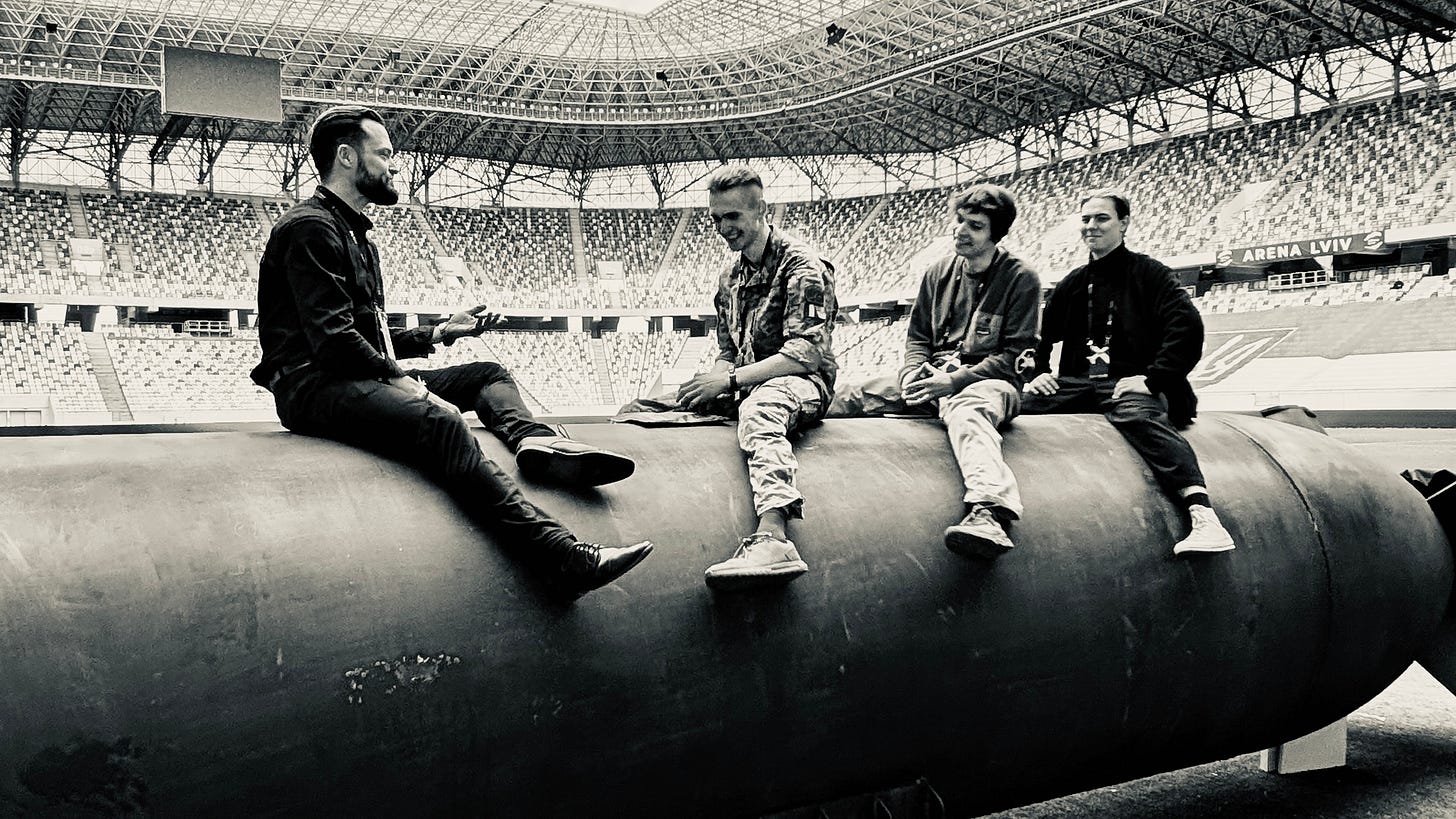The State of AI and Autonomy in Unmanned Vehicles (UxV)
Part 1: Unmanned Aerial Vehicles (UAV)
“Artificial intelligence is extremely powerful … I suspect it will be probably optimized for command and control of military operations within maybe ten to 15 years, max.”
—Gen. Mark Milley
Is this what future battlefields will look like? Illustration created with Google Gemini.
“122 [of my soldiers] might have lived, if only the U.S. had sent a bigger, badder, better-capable robot army in Iraq… 80 percent of those soldiers didn’t have to die.”
—Lt. Gen. Rick Lynch
Is NATO at risk of being over-run by autonomous killer drones? Do its allied nations have enough expertise to mount a response? How far has artificial intelligence (AI) actually developed? What can and what can’t it do today, and how did it emerge? How autonomous was the Spiderweb Operation? What kinds of autonomous systems can be procured today? Where is the market headed? How will autonomous systems work with our soldiers and security forces? What about swarming? Can autonomous systems collaborate with each other already (spoiler: yes!)? Let’s talk about autonomy in unmanned systems. Welcome to The AI & Autonomy Series, Part One: Unmanned Aerial Vehicles (UAV).
What You Will Learn in This Deep Dive
Outline
Why We’re Here
Artificial Intelligences
Automated vs. Autonomous
Smart vs. Smarter vs. Intelligent
Ethical and Legal Concerns
Autonomous = Intelligent?
How Does Autonomous Flight Work? GPS-denied Autonomous Flight Demystified
Why Drones Are Perfect for Autonomous Flight
From Missions to Motion to Vision: It’s All About the Error
Vision and Sensors - What Drones Can Actually Perceive
The Role of Advanced Edge Processing
Autonomy Levels - A Simple NATO Framework for Rating Unmanned Systems
Unmanned Aerial Vehicles (UAVs)
Evolution of UAV Autonomy: From Remote Targets to Semi-Autonomous Hunters
The Dawn of Loitering Munitions and Glimpses of Early, Simple Autonomy
The Evolution of Unmanned Combat Aerial Vehicles (UCAVs)
UCAVs Today and Tomorrow
Micro and Mini UAV: State of the Art Autonomy and Swarming
Early Swarming Experiments
Mini and Micro UAV in Use in Ukraine - Autonomous Drones and Upgrade Kits
The Price of Admission
Autonomy Levels Across Different Drone Types and Mission Profiles
The State of Play in UAV Autonomy
Mythbusting, Conclusion and Outlook
Recommendations for MoDs, Industry & Investors
Don’t worry, it’s not just quantity. But it’s actually this much content…
Hello. Thank you for supporting my work. I provide technical knowledge and market intelligence about unmanned systems and AI for governments, OEMs and investors. If you’ve been following me on LinkedIn, you know about my passion for research and writing, and how I have diligently been posting every day for as long as I can think back. This is the next chapter.
I write the most comprehensive strategic deep dives (this one has around 15.000 words), full of primary research, intelligence and experience I gather myself, from the offices of OEMs and startups to the forward edge of innovation in Ukraine.
They’re being read by MoDs, OEMs and SMEs, as well as their investors in PE, VC and banking. The TECH WARS Deep Dives take roughly a month to research and write (I use zero AI to write them), are published bi-weekly, and are supported by my subscribers. The idea is that the information is orders of magnitude more comprehensive and valuable than the monthly subscription you pay for it! Go ahead and give it a try - you can cancel risk-free anytime!
Outline
In the race for deterrence and rearmament, EU nations are confronted with a hard truth: no matter how many defense systems they buy, they will ultimately be facing an insurmountable manpower shortage for years to come. Simultaneously, the looming danger from above, in the shape of deep strike drones like the Russian Geran (Iranian name: Shahed) and its decoy counterparts like the Gerbera, threaten to overwhelm the EU’s capacity for air defense, both in terms of cost-exchange ratio and in terms of magazine depth. NATO’s Eastern Flank consists of 4.300 kilometers of terrain of various types and complexities, and long-range detection and mitigation of incoming missile and drone threats remains a massive challenge. Recent increases in adversarial drone incursions over critical infrastructure like airports have led to closures and uncertainty, as security forces scramble to adapt to new rules of engagement. The Ukrainian battlefield clearly shows that ground-based engagements, as well as those at sea, are - and have to - increasingly being fought at a distance. As European and American companies large and small race to develop solutions to these challenges, one core question remains: will these solutions work on their own? And if so, how, and to what extent? How is it that both the war on the frontline as well as the battle for the skies is still very much being fought by soldiers, and how come the lack of soldiers is being characterized by both sides as an actual problem?
In this TECH WARS Deep Dive series, we will explore the topic of autonomy in unmanned systems, the use of AI for war-fighting and defense, and manned-unmanned teaming - as well as unmanned-unmanned teaming. We will dive deep, as always, into the history, the current state of the art, and look into likely future developments ofd this most decisive technology. We will cut through the hype and marketing, dissect, examine and debunk myths and falsehoods about this topic, and empower you to counter potentially false claims with piercing questions that reveal a supplier’s actual state of development. We will probe beyond buzzwords into the actual technological basis for these systems, and look at lots of real-world examples for its current use in defense, as well as future developments.
Expect an in-depth analysis organized by domain (air, ground, maritime) and by representative systems, starting with the air. For each, we outline the historical evolution of autonomy, the state-of-the-art capabilities (and limitations) of major unmanned systems currently in use and in development, key suppliers and programs across North America, Europe, and Asia, and typical concepts of operations (ConOps). By examining situation by situation and system by system, we will debunk misperceptions and highlight what each vehicle can and cannot do without human aid. An autonomy rating is assigned to all major systems on a simple 4-level scale for comparison. Finally, we synthesize these findings to present a realistic picture of how far autonomous operations have come, and how far they still have to go, with learnings both for the battlefields and in hybrid warfare scenarios.
Yours truly speaking about claims of autonomy during the most recent episode of the Defence Innovation Podcast. Video: Defence Innovation Podcast
Before we get into it, a little housekeeping. After making it into the Global Top-30 Rising list with my first ever paid article, my second one has pushed me up to spot number 17. Surrounded by Pulitzer Prize Winners. How!? I was and still am flabbergasted. To escalate things, more than twice as many as last time have purchased a TECH WARS subscription.
I am as grateful as I am surprised.
“Your articles are like cheat sheets ”
—a reader (thanks!)
Screenshot from my note about the upcoming topic poll. Am I missing anything? Let me know in the comments!
With my thanks one more time to every one of you, let’s get to it.
Why We’re Here
Unmanned defense vehicles, whether drones, ground robots, or uncrewed naval vessels, have become ubiquitous in modern military operations. They take on missions considered “dull, dirty, or dangerous” for human personnel, from long-endurance surveillance to bomb disposal. Over the past decades, these systems have become more and more hands-free, or fire-and-forget. Most recently, between the and the 2014/2022-present Russo-Ukrainian war and the 2020 Nagorno-Karabakh war, as well as in recent conflicts between Israel and Hamas, and between the United States, Israel and the Houthis, among others, a transfer of learnings and technology from technological advances in fighter jets, as well as larger medium-altitude- and high-altitude-long-endurance (MALE/HALE) drones, over to smaller NATO Class 1 mini- and micro-drones has taken place. Born out of desperation (lack of artillery shells), and driven by miniaturization and economies of scale in commercial electronics production, as well as an evolution in computer vision and simple tinkering, this change in tactics led to a “Cambrian Moment” in unmanned warfare technology and tactics. The result is the rise of unmanned vehicles (UxV) for a variety of tasks, far from being limited to a substitute for small missiles, mortars and artillery. This has been called a second precision-strike revolution, or unmanned systems revolution by some.
Based on this development, a rise in production and variety of specialized drones, as well as further automation of their operations has taken place. Accompanying this rise is a wave of claims about artificial intelligence (AI) and autonomy in these systems. In popular discourse, one frequently hears of “autonomous” or “intelligent” drones. More and more frequently, autonomy is used as a silver-bullet-style term in marketing, with many systems suppliers claiming “full autonomy”. But what does autonomy mean, and what is needed for full autonomy? It is crucial to dissect these claims and understand what level of autonomy these systems truly possess, in order to make the right decisions when building, investing into and purchasing autonomous unmanned systems.
One more thing:
I want to make this a demand- and community-driven publication. This means that you will get to vote on what I write about, and discuss the topics with me in our community chat. Founding Members also get to hang out with me in a Q&A video call once a month. I’m not writing these for myself, but for you, and I’m always open for suggestions, so feel free to send me a message anytime.







